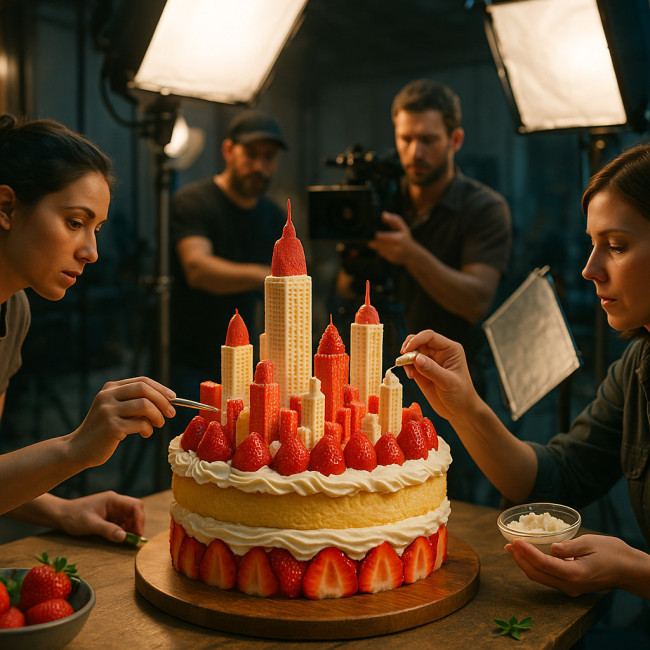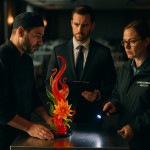Licensing edible art for media shoots: usage rights and perishable asset clauses
Edible sculptures, hyper-realistic cakes, and candy installations delight viewers and boost brand recall on screen. Yet, because they can melt, crumble, or spoil, licensing them for photo, film, or livestream projects demands clauses you will not see in standard prop agreements. This guide explains the must-have usage rights, the extra safeguards for perishable pieces, and fee benchmarks so you negotiate contracts that protect both the culinary artist and the production team.
Why edible art is different from standard props

Unlike a wooden backdrop or a resin statue, edible art changes in flavour, texture, and safety every hour. That volatility affects insurance, reshoot planning, and even how long a production may legally keep footage in circulation. Ignoring those factors exposes you to health-code fines and expensive re-creation costs. For deeper compliance insights, consult our health-code checklist for edible installations.
Core usage rights to negotiate
1. Media types
Specify every output the footage will touch—broadcast TV, social reels, OOH billboards, NFTs, etc. Culinary artists often charge a base rate for “all digital” and layer print or theatrical releases as add-ons.
2. Territory
A local café commercial might only need national coverage, but a streaming platform usually demands worldwide rights. Wider territories multiply the fee because they reduce an artist's ability to repurpose the same concept elsewhere.
3. Duration and renewal triggers
Perishable art is time-bound; so should your license. Common windows include 30, 90, or 365 days. Renewal options should trigger automatically before expiry so the client avoids takedowns mid-campaign.
4. Exclusivity scope
If a brand wants to be the sole user of a strawberry-shortcake cityscape, exclusivity prevents the artist from re-creating similar pieces for competitors. You can soften the clause by limiting it to a sector—e.g., “no other bakery brands.”
5. Credit & moral rights
On platforms like Artfolio's craft-designer showcase, visible credit links drive future bookings. Require on-screen or caption credit where feasible, and prohibit edits that distort the artist's culinary vision.
Perishable asset clauses: risk management you can't skip
Hold time and on-set storage
- Temperature controls: Spell out fridge and freezer specs, especially for buttercream structures.
- Allergy segregation: Store nut-free pieces separately to avoid cross-contamination.
- Consumption waiver: Background extras love free cake. Add a clause stating the art is “for visual use only” unless safety tests clear otherwise.
Reshoot contingencies
Because a chocolate fountain can seize under hot lights, define who funds a rapid rebuild. Options:
- Artist-backed guarantee: One free replacement if failure results from workmanship.
- Production-backed contingency fund: 20–30 % of the art budget held for emergencies.
For smooth alignment on creative expectations before shoot day, review our briefing template for culinary artists.
Disposal & sustainability
Outline how leftover elements will be handled—donations, composting, or staff meals. Clear instructions reduce waste and support CSR goals that modern brands value.
Sample licensing fee benchmarks
Below is a snapshot of current market rates for single edible-art hero pieces in mid-budget shoots (USD, 2024).
| License duration | Territory | Media scope | Typical fee |
|---|---|---|---|
| 1 shooting day usage | Local | Digital only | $250 – $400 |
| 7 days | National | Digital + PR stills | $600 – $900 |
| 30 days | National | Digital & Print | $1,200 – $1,800 |
| 90 days | International | All media | $2,400 – $3,500 |
| 365 days | Worldwide | All media | $5,000 – $7,500 |
When exclusivity extends beyond 12 months, many artists switch to a royalty model—see comparison tactics in our royalty-clause primer for limited editions.
Negotiation checklist
- Define deliverables: hero piece, backup, and edible color-match swatches.
- Attach care instructions with responsibility hand-off times.
- Align on visual continuity: camera tests for melting risk.
- Secure insurance certificates: food product liability + production policy.
- Plan publicity rights: behind-the-scenes stills often boost portfolio value.
Quick communication tips
Clear, concise messages accelerate approvals and minimise misunderstandings. For guidance on outreach that avoids inbox fatigue, revisit our etiquette guide on engaging recruiters without spamming.
Mini-quiz: Test your edible-art licensing IQ
FAQ
- Can I extend a 30-day license after the campaign goes viral?
- Yes. Most agreements include a pre-negotiated renewal rate, often 80–100 % of the original fee, activated before day 30 ends.
- What happens if the edible art spoils before shooting?
- The reshoot contingency clause decides liability. If spoilage results from set conditions outside the care spec, the production covers replacement costs.
- Is insurance mandatory for small social-media shoots?
- While not legally mandatory everywhere, productions risk out-of-pocket losses without product-liability coverage. Many culinary creators require proof before delivering.
- Can the crew eat the art after wrap?
- Only if the contract and local health codes allow. Add a written waiver and a time-stamp on safe consumption before you slice that cake.
- How early should I book a culinary artist for complex builds?
- Four to six weeks is standard. Intricate sugar or chocolate structures may need longer for design approvals and ingredient sourcing.
Master these clauses today and you will save hours of back-and-forth tomorrow—ensuring your sugary showstopper shines on screen, on time, and within risk-managed budgets.











